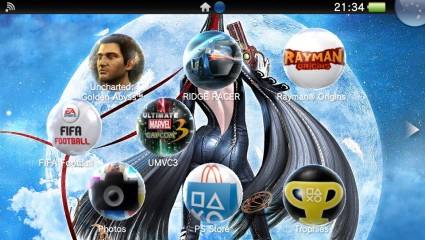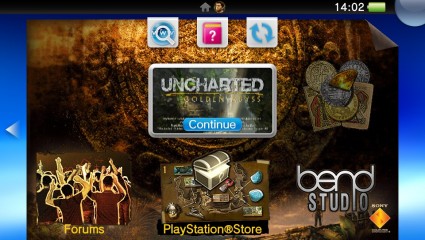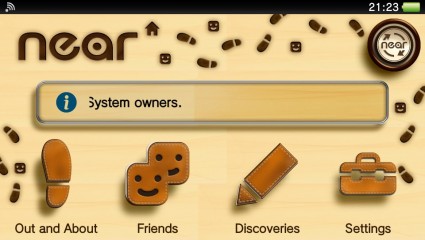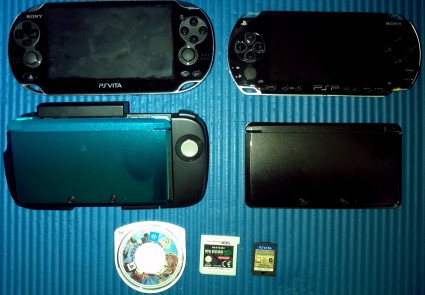Reviews
PS Vita
February 28, 2012, Author: Andy Corrigan
As a standalone device, the PSP sold relatively well; however, it’s hard to deny that it never really lived up to its early promise. For every truly great game, for every Crisis Core, Grand Theft Auto, or LittleBigPlanet, there were ten crap games not far behind them. It also failed to provide the true home console experience touted, hindered by only having one analogue stick, leaving many core games feeling gimped with less than ideal workarounds. It was a nice piece of kit for its time, true; but the public have been ready for a successor for a number of years, and none of the revisions were enough to satiate users.
Step forward PS Vita. It’s finally here, not only rectifying most of the PSP’s design failures and adding a ton of new features, but also boasting a raw power that’s unprecedented in the handheld arena.
Sony have clearly aimed high; have they delivered?
I have to say that first thing that surprised me when taking the Vita out of the box, was just how light the device was. The old PSP (thanks mainly to the UMD tray) felt a tad rickety but was reassuringly weighty. Fear not; the build quality on the Vita is excellent. It’s sturdy and seems like it’d be durable, certainly more so than the 3DS, which feels a tad fragile in comparison.
In its actual design, the Vita inherits most of its good looks directly from its older brother. They’re practically twins. In fact, they look so alike that I still find myself trying to find the Start and Select buttons across the bottom bar, rather than below the right stick. Elsewhere, the power and volume controls are positioned on the top ridge at either side, with the covered cartridge slot positioned between them but slightly to the left, while the memory cart port is found underneath alongside the headphones jack and the charge port.
The size was the second thing that hit me. The screen, at 960 × 544, is huge compared to its predecessor and looks lovely in action (more on this later). Obviously, the device itself is sizeably bigger to compensate. The plus side is that it’s more than comfortable to hold, with all the controls sitting perfectly for your thumbs.
The dual analogues, which are proper analogue sticks and not thumb nubs, feel natural in spite of their diminutive size. They feel loose and free, and once in a game that uses both, you’ll feel right at home. To combat your fingers accidentally touching the rear touchpad, there are two shallow pockets either side of the grip for you to rest your fingers in. These usually feel comfortable during gameplay, but it can depend entirely on what you’re playing. If I had one complaint with the control interface, it’s that the face buttons are incredibly small and very close together, but it’s nothing you can’t get used to after a short play around with the system.

You can customise the menu to a decent degree. Take the hint Platinum Games!
It’s when you boot up the Vita that you get to see how lovely the screen is in action, although it is a fingerprint and smudge magnet. Still, it looks lush and rich in colour, capable of HD graphics. The Vita uses a new menu system (along with a new, relaxing backing track!), ditching the aging XMB and providing something that fans of touchscreen devices will be instantly familiar with.
When games and apps are installed they appear in bubbles on the pages, and you can have several pages full of software. You flick through these upwards and downwards, with a motion like you would do on any iPhone or Android device. In fact, the similarities to other touch devices don’t stop there, as you can hold down on the screen and then move the icons around in an identical fashion. A nice feature is that you can set a different wallpaper for each page, allowing you to organise them how you wish. At any one time, you can have up to one game and five other apps or pages open, and from the home screen you can flick through these by going left to right; it’s a slick system.
In playing with the menu, you’ll realise how nicely the touchscreen works. The DS’s touchscreen has always felt more like an old PDA than a modern touchscreen device, whereas the Vita really does have the feel of an iPad down pat. In fact it does this a little too well, as you can’t actually navigate the menu with anything but the touch interface, which seems a bit odd.
The rear touchpad works almost just as well, but is only used in gameplay. We’ll discuss its implementation a little more in individual software reviews as its usage can be practically anything, be it shooting in FIFA, rotating items in Uncharted or acting as an alternative to the lack of secondary shoulder buttons.
Whenever you put in a new cartridge (which are tiny little things, even smaller than the 3DS’s cart of choice), the Vita installs what’s known as a LiveArea. This is like a hub page for each piece of software. So, for example, you put in the cartridge for Uncharted: Golden Abyss and tap on the software icon for it, and it will open the LiveArea for that game. Along the top are buttons with which you can install new updates, read the manual or visit the official webpage, right on the fly. Below on the LiveArea screen itself you can boot the game, follow a link directly to any DLC, or to anything else that the developers feel is important, such as their community forums.

This is an example of a LiveArea screen.
Talking of websites, the Vita’s browser is a huge improvement on the PSP’s, thanks mostly to the touchscreen controls. Navigation is a joy, and I haven’t hit many issues, but when I have they’ve ironically only come when visiting Sony’s own sites. Following the pre-order bonus code registration was impossible, thanks to display issues when trying to sign in and linked buttons just not working.
The Vita comes with other apps and features already installed. You can access your friends list, send messages exactly as you can on the PS3; though oddly, you can see what your PS3 friends are playing but they can’t see you at all. Maybe a patch later down the line will solve this; we all know how Sony love those!
Of course, a huge plus in the Vita’s favour is that all of its games feature Trophies, and the system benefits greatly from having these right out of the starting gate, unlike the PS3’s gradual inclusion. Those unlocked can be viewed and synced from the dedicated trophy application, and they count towards your overall level when combined with your PS3 awards.
‘Near’ is the Vita’s version of Streetpass, only it’s nowhere ‘near’ as classily implemented. If you don’t have a 3G model you’re going to have to be connected to Wi-Fi for it to work; devices can’t pick each other up, despite allowing ad hoc multiplayer. When connected to the internet and the software loaded up, it detects your location using Google Maps (already installed) and finds out who is near you within a set radius.
From here you can see what the most popular games are in your immediate area thanks to a voting feature, see others’ status updates and look at trophies. You can add people found on here as friends, and invite them to certain games. It seems nicely woven together; however, for me it makes Near the Vita’s version of PS Home; a nice concept that’s ultimately pointless. Something I’ll seldom use.

Near. Not as interesting to me as Streetpass, unfortunately.
There are far better ways to communicate with your fellow gamers included on the console. Group Messaging is a text message style service that keeps a constant log, just like an iPhone; whereas Party allows eight people to communicate (voice or text) while they game, no matter what game they happen to be on. You can also join in matches and games from this very application. Nice one Sony! Finally!
Not to be outdone by the 3DS, the Vita also comes packed with Augmented Reality cards and three free games to download to test them with. Those included are Table Football, which is like Subbuteo lite, where you build your stadium using all the AR cards and then flick players and the ball to work goals; Cliff Diver, a fun, non-game about diving; and Fireworks, a limited arcade game where you detonate Fireworks in the sky above AR-generated houses. All of these plonk the action smack in the middle of your desk, or wherever you lay your cards. These are a fun little distraction, which merely hint at the possibilities of Augmented Reality rather than seriously impressing.
The Vita’s PSN marketplace has been live since the console officially launched; however, the content there is fairly limited at the moment, as you’d expect. You’re currently restricted to full Vita games (which are slightly cheaper than retail), demos, PSP games (with some glaring omissions at present), and a couple of social applications (Live Tweet is a brilliant piece of software). Currently absent are PSOne classics, but I’m told they’re coming soon after the next system update. You can queue up your downloads too, and manage them easily by hitting the bubble in the top right of the menu screen, acting as your activity feed.
Lastly, in terms of included software I want to touch upon the Content Manager, which makes managing what’s on your Vita a pretty painless affair. Using this you can connect to your PS3 or a PC via USB (I couldn’t do the former as my console is still in the UK), and then browse and move your content to and from your Vita and make a back-up of its current state. Useful. Here you can also move any PSP games you own digitally onto your shiny, new console. Although there’s an install on the PC, there’s no client; it’s all managed via the Vita. Slick, and unusually user-friendly for a Sony device.

A crude size guide I quickly knocked together.
Battery life, then. It’s certainly no worse than the 3DS, but it’s clearly no better, so roughly around four hours depending on what you’re doing with it. The thing is, there’s enough juice here for I’d call ‘normal usage’. As a loose example, I played it all day on Sunday, switching between Uncharted, Rayman and FIFA, and I found that I had to recharge it twice over the course of the day. This is obviously not normal usage for a handheld.
The reason is, of course, that it’s new to me. I’m in the honeymoon period at the moment, and I’m going to play it to death a lot for the time being, just as I did with my 3DS. However, as you work it into your normal daily routine, playing on lunch times and toilet breaks while at work or at school, then some more when you get home, you’ll find that the battery life is just about sufficient. It would have been nice to get a solid six-eight hours or more out of it, I totally agree, but with a ‘normal usage’, it does the job.
It’s something at least, that when charging directly from the wall socket, it fully charges in well under two hours. USB charging, on the other hand, is a different kettle of fish. Firstly, you need to make sure that the Vita is enabled to charge by USB by visiting the settings, but even then it’s not clear that it is. Charging from the wall socket gives you a spark animation to indicate that it’s plugged in, while charging via USB doesn’t. Still, I tested this out and the bar does eventually ascend; it’s just a lot slower.
There are things you can do to lengthen the battery life, such as turning off Bluetooth if you’re not using it (you can use Bluetooth headsets in Party, for example), while some games seemingly attempt to help the battery life themselves. Uncharted appears to be fully aware that it’s a single-player affair, killing all network usage during gameplay.
The only point of contention, really, is in the cost. The console, 3G or not, already comes at a hefty price at £230-280 ($350-$418 over here in Aus), but then to play any games you require a memory card, only sold separately. The largest of which is currently available at roughly the price of a game. Of course, this is nothing new; the PSP needed a memory card, but in making it a proprietary card they’ve made sure that (for the time being at least) you have to get the Sony branded one. It surely couldn’t have been too much of an issue to include a token 512mb, just to get people up and running?

Seeing this running in the palm of your hand is truly a milestone moment.
Let’s wrap this up then. Despite the cost, you’re looking at a revolutionary piece of hardware. The machine is certainly capable of great things; seeing Uncharted and Ultimate Marvel vs. Capcom 3 running flawlessly on it for the first time is truly a milestone moment for portable gaming. These are full games with very few concessions made.
It’s literally amazing to play a fast-paced and fluid third person shooter like Uncharted flawlessly, without it feeling gimped somehow and having to justify it by saying that it’s ‘okay for a handheld’.
That said, the Vita’s success relies on two factors. Consumers need to prove that they want full games on the go by taking the plunge on a tasty piece of equipment, but more importantly, developers really need to deliver this time around. No more half-assed products just because it’s a handheld. The Vita deserves better.
Should you buy? If you want the home-console experience in the palm of your hands alongside more typical handheld experiences, then yes, it’s totally worth the money. This has all the potential to be a game-changer for the industry, and my gut feeling is telling me that there should be bright times ahead. It’s certainly started well, with one of the strongest launch line-ups I’ve seen in years. Long may that support continue.
Our Vita software reviews will be appearing on the site over the next few weeks!
Platforms: Product Reviews, PS Vita | Tagged escape plan, FIFA Football, Nathan Drake, Playstation, Playstation Portable, PS Vita, PSP, rayman origins, Sony, Ultimate Marvel vs. Capcom, UMvC3, Uncharted, Uncharted: Golden Abyss, Vita



